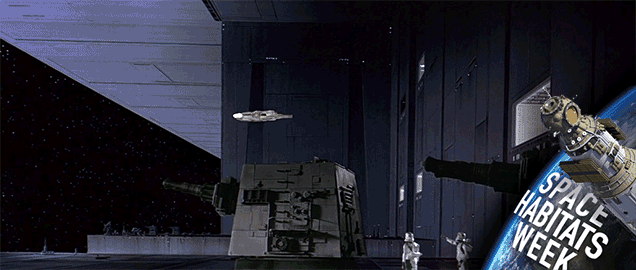Humanity’s future in space is one of endless theories, plans, and concepts. Will we float among the stars in crazy spaceships? Will we set up small camps that sprawl into townships that grow into cities, or is an orbital mothership more human friendly?
While scientists, physicists and experts are asking these starbound questions about how we might survive in space, we also already have several fleshed out concepts, courtesy of a near-century of science fiction. Giant space stations the size of moons. Huge ring-shaped habitats orbiting other worlds. Massive cities floating in a more hospitable alien atmosphere.
The question is, could any of these really be possible? Or do they deserve to be forever enshrined as sci-fi fever dreams?
I contacted Sydney Do, a research fellow and doctoral candidate at MIT who systematically dismantled the doomed (let’s be honest) Mars One mission and has written a litany of research on space habitation, to comment on whether any iconic scifi examples of space habitats could actually be in humanity’s future.
There are three things you need to keep in mind when considering any type of human habitat in space, according to Do: location, function, and size. Those three criteria greatly influence what is and isn’t possible. So I whipped up a few scenarios from science fiction to put to the test.
Turns out, humanity’s got some work to do.
A mobile space station… like the Death Star

Everyone and their scifi-loving grandmother knows what the Death Star is — that big grey ball of destruction from Star Wars that sometimes moonlights a moon and not a space station. It’s a galaxy roaming planet destroyer that is itself a planet, filled with steel and stormtroopers.
So… could we basically build an artificial planet and just cruise the galaxy? I hope you’ve got some cash on hand.
“Something the size of the Death Star would require a significant amount of material to build,” Do says. Yeah, no kidding. According to White House estimates when prompted by a petition to build the Death Star (I love the internet sometimes), estimated figures came in about $US852,000,000,000,000,000 for just the steel.
But let’s say for funsies that money was no object and we made a Death Star anyways. What then? Then plain old physics would be a problem.
“The requirement for the Death Star to move through space requires unprecedented propulsion,” Do says. “The mass of the Death Star is comparable to the mass of Deimos, one of the moons of Mars — we clearly don’t have the propulsive capabilities right now to move something of this size.”
All right then, time to make those Mars boosters much, much bigger.
An orbital space station… like Deep Space 9

OK, so maybe the Death Star is a little too big (at least for now). Maybe something a little more manageable would be an orbital habitat in space, much like the space station Deep Space 9 in Star Trek. In that series (personally one of my favourites), DS9 orbits the friendly planet of Bajor — there’s also a giant wormhole but let’s forget that for a moment — and is a setup that is actually pretty carbon-based lifeform friendly. Though money could still be a prohibitive barrier.
“You would still need a vast amount of material,” says Do. “So the question would be, do you bring this material up from the planet that it’s orbiting? Or do you get this material from some kind of space-based resource (like asteroids or moons, for example)?”
According to Do, it costs about $US10,000 to deliver each pound of mass from the surface of Earth to low Earth orbit. Because of that, it might make more sense to send robotic spacecraft to mine asteroids for material rather than ferrying them from a planet.
Another thing to consider would obviously be the life-support system. In Star Trek, DS9 wasn’t a completely autonomous community with many merchants and supply missions from Bajor keeping the station ticking. Do says that would be absolutely necessary in this kind of habitat.
“Something of this size will likely operate a combination of biological, plant and algae-based life support systems and ISS-style life support system based on chemical engineering processes,” Do says. “This won’t be entirely self-sustainable, and will require periodic resupply of gases, water and spare parts.”
So maybe Star Trek gives a more realistic blueprint of going where nobody else has gone before than other designs from a galaxy far, far away.
A traditional Mars base camp… like in Mission to Mars
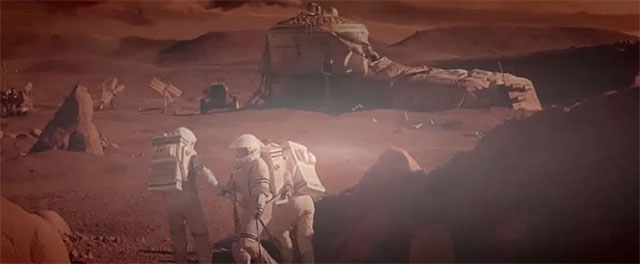
OK. There’s a lot of stuff in Mission to Mars that’s a buncha bullshit. Tornadoes on Mars? Crazy alien face sculptures? Mmmmkay. But what always struck me most about Mission to Mars is how simple, natural and not shitty their Mars habitat is. As Don Cheadle nonchalantly mentions about his plant-based habitat: “It works. I give them CO² and light and they give me oxygen and food.”
Of course! So simple! Yeah, not quite, says Do.
“In principle, a Martian greenhouse is possible. However, growing crops introduces complexities that need to be managed, and when you compare the costs and benefits of growing crops versus carrying food for a Martian mission, it makes more sense to carry mostly prepackaged food from Earth, and to supplement this food with a smaller fraction of locally grown crops that have a high harvest index (fraction of edible mass of the total biomass) and a relatively fast time to reach maturity (Salad crops are a good example).”
Although Cheadle seems pretty convinced that plants and humans form a symbiotic relationship (which on Earth might be true), in the harsh Martian climate, plant and human requirements differ wildly.
Add to this, the fact that the rate of photosynthesis of crops varies as they reach maturity means that you need more complex systems to actively manage the atmospheric composition. This is particularly challenging when the crew and crops share the same environment since in many respects, they have conflicting atmospheric requirements. In practice, you would grow crops in their own dedicated plant growth chamber to reduce this added complexity, but this then increases your requirement for equipment.
Growing crops is a great idea… but you better have some astronaut food for added sustenance.
An upper atmosphere space station… like Cloud City
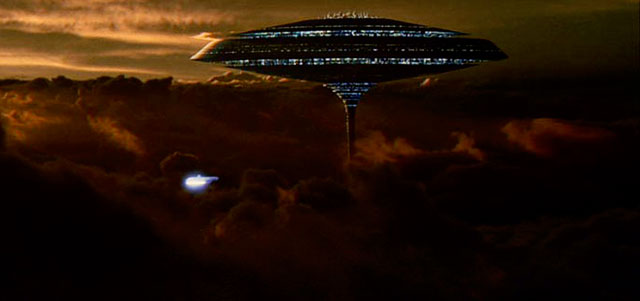
Lando’s Calrissian’s famous “city in the clouds” is romantic and a pretty cool bit of science fiction, but could any planets with dense atmospheres but hostile surfaces provide a goldilocks zone for humans to actually survive and thrive? NASA seems to think so, and that planet’s name is Venus.
The Langley Research Center has been exploring this very idea and is still working on concept vehicles that could send humans to Venus’ upper atmosphere. We’ve already mentioned how huge city-sized stations would be hard — if not impossible — to fund, but the trickiest part may be getting a spacecraft to rest in a planet’s upper atmosphere in the first place.
“Atmospheric entry is one of the toughest challenges in spaceflight,” Do says. “You may recall the ‘seven minutes of terror’ of the Curiosity rover’s landing. This would be much more difficult for a floating habitat, where you enter the atmosphere at thousands of miles per second, and have to deploy an inflation/floatation system and slow down to a zero velocity in the few minutes that you have before hitting the ground.”
Also, where Calrissian’s floating fortress had the benefit of clearly breathable air, most likely you won’t find such a similar situation in outer space (and especially not Venus). That means different space suits would have to be developed, and you’d still need something to get you supplies from Venus’ hellish surface. Do has a few ideas:
For an atmospheric habitat, depending on the location, you could process the atmosphere around the habitat (on Venus you could process the CO2 to retrieve O2 for example), or you might be able to send robotic miners to the surface, possibly via tether, to extract resources and deliver these back to the habitat (on Venus, the extreme surface conditions would make this very difficult). Otherwise, you’d have to send these resources to the habitat in a manner similar to original deployment of the habitats — using some sort of entry and inflation system.
So Cloud City seems like a definite no. But Cloud Outpost? Well, now we’re talking.
Giant Spaceship Habitats… like in Wall-E
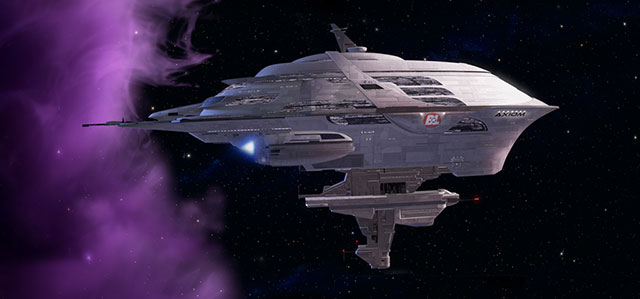
Wall-E, while being the most adorably cute piece of science fiction on this list, paints a relatively realistic portrait of humanity ditching Earth on giant spaceships until robots can clean up our dirty den of a planet for us. That’s doable, right? I mean, we already have spaceships designed for humans. Let’s just make it bigger!
Actually, this might be the most far-fetched idea of any science fiction film here. Do explains why:
In the case of the Wall-E spaceship, the habitat is in deep space, so its access to any resource external to the habitat is essentially zero (for example, the habitat would have to be nuclear powered since it would be too far from our Sun or other light sources for solar power to work effectively); and it has a population of several thousands of people, all of which consume food, water and air that needs to be supplied from somewhere, and produce waste that needs to be managed.
Even if some form of biological support system were implemented, the energy-poor environment of deep space that the spacecraft is in would mean that there would be insufficient energy to support these biological processes. In short — this is one of the more far-fetched scenarios.
Sorry, fat Wall-E humans. Science says you should be dead. But hey, great movie though.
A halo world… like in Elysium
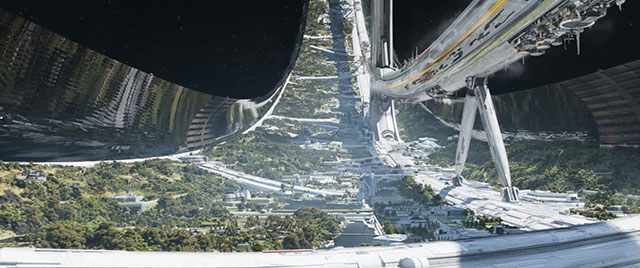
Ring worlds — like in Elysium or the popular Halo video game series — are by far the coolest space habitats ever imagined. In the Elysium example, its close proximity to Earth makes it a relatively good candidate for plausibility if you ignore its gargantuan size. But the biggest problem is its open air design — that just doesn’t make a whole lot of sense.
“Probably the biggest oversight with the Elysium concept is that the habitat is open to the space environment,” Do explains. “A spaceship simply lands on a grassy field after entering from open space. This habitat would definitely need to be entirely enclosed to contain the atmosphere. The skin could be a flexible transparent membrane to allow natural sunlight to enter to sustain any plant-life that is grown inside the habitat.”
Cool habitat, but if you like breathing it might be kind of a bummer.
An underground base… like in The Matrix?

OK. I know I know I know I know that The Matrix takes place on Earth. But the surface is so fucked up by the antagonistic robits that the Earth might as well be some sort of hostile alien world. So… living underground to be close to a planet’s core for warmth does make sense, but the biggest challenge — apart from transporting the equipment needed to actually excavate an underground colony — would be keeping in contact with the rest of the human race. Do uses Mars as an example:
Underground habitats inherently have challenges related to communications outside of the habitat. Communicating from an underground Mars habitat to the Earth requires communications lines that run to the entrance of the geological feature, and satellites in orbit above Mars to relay signals to Earth. If a constant line of communication is required, at least one other satellite situated in orbit around the Sun is required to enable communications when the Earth is on the opposite side of the Sun to Mars. In this case, this secondary satellite relays communications signals around the Sun and towards Earth.
So maybe? If you’re willing to cease all contact with the human race, which to be honest, is the beginning of many, many science fiction horror films.
A carved-out asteroid…like in 2312
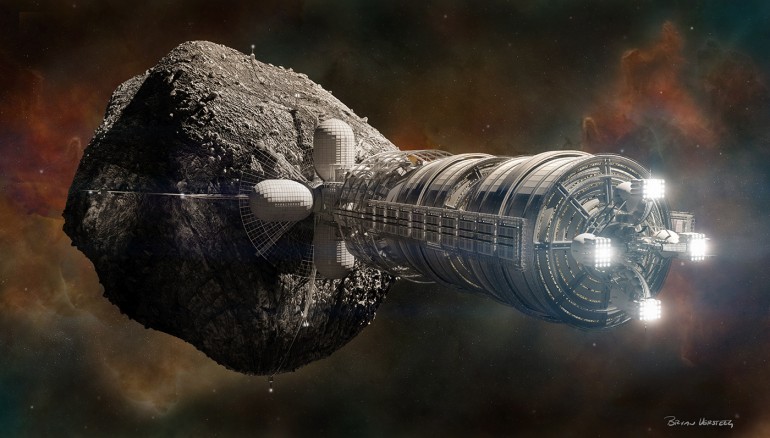
So yeah this is a book but it’s a great book so I’m including it. In this novel by Kim Stanley Robinson, humans carve out an asteroid and build a type of terrarium, which uses centripetal force to create artificial gravity.
NASA expert Al Globus says one big challenge would be making sure an asteroid is airtight considering most asteroids are just giant piles of rubble. He says asteroids are also very hard to spin up and changes in center of gravity would require constant course correction.
But of all space habitats this one could actually be possible. You just got to find that special flying chunk of rock to call home, says Do.
NASA is attempting to do something very related to this concept with its Asteroid Redirect Mission.
The challenge in this is selecting the right asteroid — one with the right structure and orbit, for it to be valuable. There have been concepts where asteroids are put in periodic orbits between Earth and Mars and modified to act as crew transports between the two planets. The extra mass around the asteroid provides shielding against the harsh space radiation environment.
The main challenges associated with this concept would be moving a habitat-sized asteroid into the desired orbit (this would require propulsive capabilities beyond what we currently have), and mining and processing the materials on the asteroid, as we have no experience in doing this.
The constraints of moving such a dense object would mean that this habitat would be more suited towards a smaller crew of about 4-6 people, rather than something at the colony scale.
Asteroids, man. Who knew.
Additional reporting by Abhimanyu Das. Asteroid habitat image by spacehabs.com.
